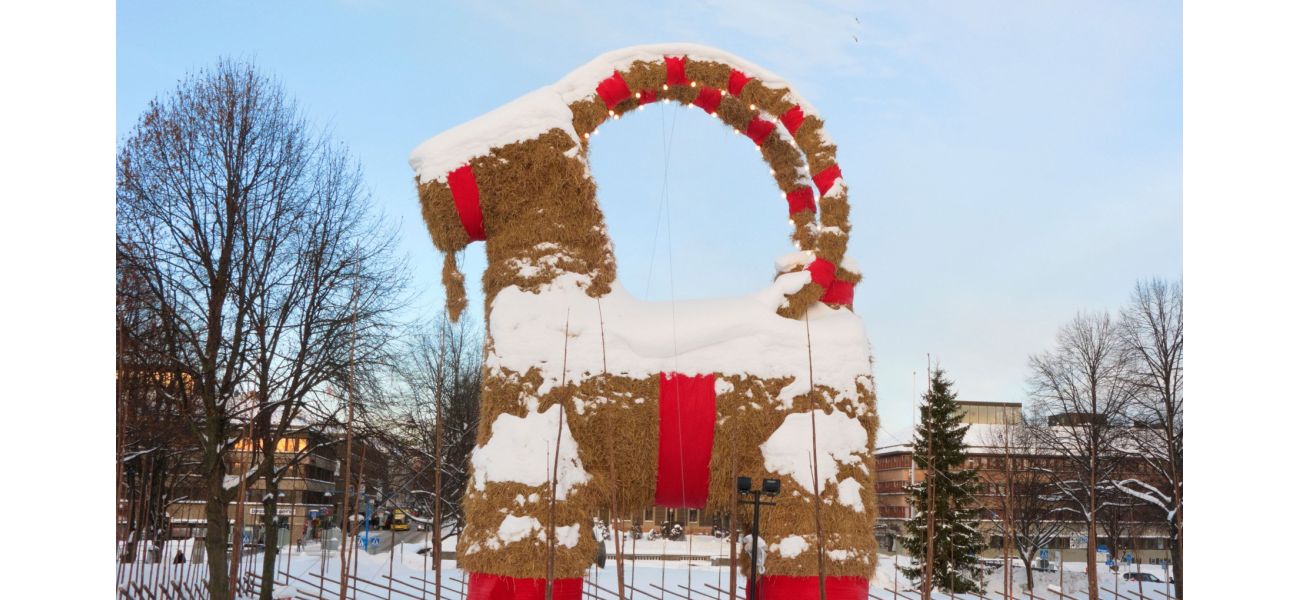People are continuously attempting to destroy Sweden's enormous Christmas goat.
December 9th 2024.

Every December, the charming streets of Gävle, a city in Sweden, are graced by the presence of a 13-meter tall Christmas "goat". This beloved tradition of erecting a giant goat made of straw dates back to 1966 and is believed to have origins in German paganism or Norse folklore. It is often associated with Thor, the god of thunder, and is seen as a symbol of fertility and prosperity.
Although the Gävle goat has become a symbol of joy and generosity, it has also faced numerous threats over the years. In fact, of the 58 goats that have been displayed, a staggering 42 have been destroyed. Not just by fire, but also by being run over by cars and beaten with clubs. This strange tradition of attacking the goat started in 1966, the same year the first goat was displayed at Slottstorget.
In 2023, the goat faced a new enemy - birds. Due to an unusually rainy harvest season, it was difficult for Swedish farmers to gather enough straw for the goat. This resulted in an army of jackdaws making a home on the goat's horns and picking away at the straw to feed their families. Surprisingly, the birds were not punished for this act, as it was seen as a natural occurrence and not a malicious attack.
The goat's spokesperson, Anna-Karin Niemann, stated that they chose not to scare away the birds as it would go against the spirit of Christmas. This year, the unveiling ceremony of the goat was even live-streamed for people around the world to witness.
As unique as the Gävle goat tradition is, it is not the only quirky Christmas tradition around the world. In Italy, children receive gifts from the Befana, a witchy old woman, on January 5th. In Norway, families hide their brooms in cupboards to protect them from witches on Christmas Eve. And in countries like Germany, Austria, and Hungary, naughty children are scared by the devil-like creature, Krampus, instead of receiving coal from Santa.
In Venezuela, people roller skate to Christmas mass from 16 to 24 December, a tradition known as "las patinatas". These are just a few examples of the many unique and intriguing Christmas traditions around the world.
Despite the city's efforts to protect the goat, it has faced many challenges over the years. In 2005, it was set on fire with burning arrows, and in 2010, someone even attempted to steal it with a helicopter. However, the goat remains a beloved and cherished tradition, with people from all over the world tuning in to watch its unveiling every year.
The Gävle goat comes at a great cost, both in terms of money and time. In 2023, it cost around $26,260 and took 10 people approximately 1,000 hours to build. But for the people of Gävle, it is more than just a giant goat made of straw. It is a symbol of their city, their traditions, and their Christmas spirit. And as long as the goat continues to stand tall on the first day of Advent, the people of Gävle will continue to protect and cherish it, no matter the cost.
Although the Gävle goat has become a symbol of joy and generosity, it has also faced numerous threats over the years. In fact, of the 58 goats that have been displayed, a staggering 42 have been destroyed. Not just by fire, but also by being run over by cars and beaten with clubs. This strange tradition of attacking the goat started in 1966, the same year the first goat was displayed at Slottstorget.
In 2023, the goat faced a new enemy - birds. Due to an unusually rainy harvest season, it was difficult for Swedish farmers to gather enough straw for the goat. This resulted in an army of jackdaws making a home on the goat's horns and picking away at the straw to feed their families. Surprisingly, the birds were not punished for this act, as it was seen as a natural occurrence and not a malicious attack.
The goat's spokesperson, Anna-Karin Niemann, stated that they chose not to scare away the birds as it would go against the spirit of Christmas. This year, the unveiling ceremony of the goat was even live-streamed for people around the world to witness.
As unique as the Gävle goat tradition is, it is not the only quirky Christmas tradition around the world. In Italy, children receive gifts from the Befana, a witchy old woman, on January 5th. In Norway, families hide their brooms in cupboards to protect them from witches on Christmas Eve. And in countries like Germany, Austria, and Hungary, naughty children are scared by the devil-like creature, Krampus, instead of receiving coal from Santa.
In Venezuela, people roller skate to Christmas mass from 16 to 24 December, a tradition known as "las patinatas". These are just a few examples of the many unique and intriguing Christmas traditions around the world.
Despite the city's efforts to protect the goat, it has faced many challenges over the years. In 2005, it was set on fire with burning arrows, and in 2010, someone even attempted to steal it with a helicopter. However, the goat remains a beloved and cherished tradition, with people from all over the world tuning in to watch its unveiling every year.
The Gävle goat comes at a great cost, both in terms of money and time. In 2023, it cost around $26,260 and took 10 people approximately 1,000 hours to build. But for the people of Gävle, it is more than just a giant goat made of straw. It is a symbol of their city, their traditions, and their Christmas spirit. And as long as the goat continues to stand tall on the first day of Advent, the people of Gävle will continue to protect and cherish it, no matter the cost.
[This article has been trending online recently and has been generated with AI. Your feed is customized.]
[Generative AI is experimental.]
0
0
Submit Comment





